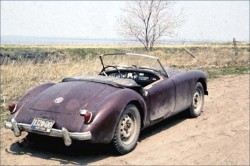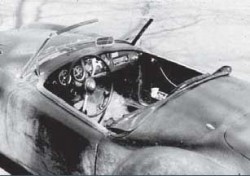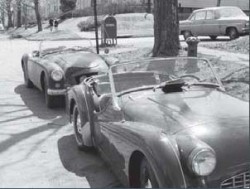The Trip North

 In the late spring of 1968 a college classmate of mine easily convinced me to purchase his 1956 MGA 1500 for the exorbitant sum of 150 dollars. After all it was a twelve year old car but I was hooked. The seller was graduating and leaving school, the owner of a new MGC. Having driven a friend’s Austin Healey 3000 a few months before, I was itching to purchase a British sports car with an MG being at the top of my list.
In the late spring of 1968 a college classmate of mine easily convinced me to purchase his 1956 MGA 1500 for the exorbitant sum of 150 dollars. After all it was a twelve year old car but I was hooked. The seller was graduating and leaving school, the owner of a new MGC. Having driven a friend’s Austin Healey 3000 a few months before, I was itching to purchase a British sports car with an MG being at the top of my list.
At the start of the summer I drove the MGA to work in a summer camp in the Berkshires and then home to Queens, New York for the fall. I used the MGA to drive to my student teaching assignments in New York City while living at home and then planned on returning to college when the new semester began in February 1969.
 On the day after my student teaching assignment ended, I packed up the MGA with all my worldly possessions and headed back to school. A large trunk on the passenger seat and in the foot well took up most of the space next to me. In addition, more clothing, books and tools in every other empty spot the MG had. I figured that the trip to Oswego, New York would take about six hours to cover the 350 mile distance. My destination was a small farm house in Mexico, New York where friends were living five miles outside of the college town.
On the day after my student teaching assignment ended, I packed up the MGA with all my worldly possessions and headed back to school. A large trunk on the passenger seat and in the foot well took up most of the space next to me. In addition, more clothing, books and tools in every other empty spot the MG had. I figured that the trip to Oswego, New York would take about six hours to cover the 350 mile distance. My destination was a small farm house in Mexico, New York where friends were living five miles outside of the college town.
Oswego, New York is fifty miles north of Syracuse on Lake Ontario. To give you the full picture of where I was heading is to tell you that seven foot snowstorms are common from the lake effect snow we have there, and the low temperatures coming across the Great Lakes from Canada are overnight battery killers.
At this time I will deviate to tell you about the clutch slave cylinder in my ’56 MGA. Every so often when I disengaged the clutch, the slave cylinder piston would come so far out it would #### over and stick in the lip of the cylinder bore. Not fully understanding how this could be fixed, I changed my driving technique to compensate. This is not to say I didn’t try, but with my limited mechanical skills and understanding of fluid dynamics, I chose another path. This was done by shifting with the pedal ¾ of the way down.
I began the drive north from New York City, at 2 PM, stopping on the New York State Thruway at the first service area to gas up for the remaining 320 mile trip. With twelve gallons in the MGA, at thirty two cents a gallon, I was ready for the non-stop trip to the north.
 On the exit ramp coming out of the service stop my shifting technique failed, the piston stuck and the clutch stuck wide open. I drifted to a stop by the side of the on-ramp. This was not the best place to be located as numerous tractor trailers would blow by at seventy plus, throwing salt dust in my face as I attempted to free up the clutch. With all the force of the clutch spring against the piston, the only way to release the clutch was to remove the two bolts from the slave cylinder and insert the piston back in without getting air in the system and losing fluid. Having practiced this several times before, I squeezed under the side of the car, wrench in hand, and removed the two bolts to free the assembly. With the pressure released, I pushed in the piston and replaced the bolts while under the constant fear of being squashed by a truck entering the thruway.
On the exit ramp coming out of the service stop my shifting technique failed, the piston stuck and the clutch stuck wide open. I drifted to a stop by the side of the on-ramp. This was not the best place to be located as numerous tractor trailers would blow by at seventy plus, throwing salt dust in my face as I attempted to free up the clutch. With all the force of the clutch spring against the piston, the only way to release the clutch was to remove the two bolts from the slave cylinder and insert the piston back in without getting air in the system and losing fluid. Having practiced this several times before, I squeezed under the side of the car, wrench in hand, and removed the two bolts to free the assembly. With the pressure released, I pushed in the piston and replaced the bolts while under the constant fear of being squashed by a truck entering the thruway.
Upon re-entering the car, I drew a deep breath, placed it in second gear and pulled the starter. The MGA jerked forward, the engine started and began gathering speed. At maximum revs in first gear I power shifted to fourth, barely touching the clutch pedal when I did.
After slowly getting up to the target speed of 65, I settled into my long journey. An hour later it began to get dark as it does early on in February. Turning on my headlights about 100 miles into the trip was the beginning of the fun that was about to happen.
The further north I went, the colder it got, and the blower motor was the next electrical device that needed to be brought online to fight the condensation forming on the windshield. As you can imagine, the condensation was all from my breathing in this small space I had made for myself.
As I passed through Albany, New York, which was about 180 miles into the journey, it began to snow and I turned on my two Cibie fog lights that I had just installed a few weeks earlier. My knowledge of electrical load and system capacities was nonexistent at this time in my life.
 In addition to the fogs, the wipers were now called upon to remove the melting snow from the windshield. In an effort to keep myself sane, I turned on the radio, bringing the full electrical load onto the Lucas electrical system. This wasn’t a standard dealer car radio but was a low end Radio Shack unit that I had slung under the dash.
In addition to the fogs, the wipers were now called upon to remove the melting snow from the windshield. In an effort to keep myself sane, I turned on the radio, bringing the full electrical load onto the Lucas electrical system. This wasn’t a standard dealer car radio but was a low end Radio Shack unit that I had slung under the dash.
As I passed through Syracuse on the interstate, I realized that I was the only fool on the road heading north into a raging blizzard. This is the lake effect zone of New York State where the cold wind from Canada picks up moisture from the Great Lakes. The road was only recognizable because the snow banks on both sides were a different color white. My driving technique was that I attempted to keep in the middle of this two lane all white highway without hitting something.
At this time the gas gauge was reading low enough to be a concern. Do the math, 270 miles with fifty miles to go and twelve gallons in the tank at the start. Now the ignition light was starting to glow. I guess it had been glowing for a while, and this small illumination was just enough to start me sweating even though the temperature on the other side of the Plexiglas side curtain was ten degrees. Anyway, I figured that if the light was on full, I would really be in trouble.
Unable to stop for fear of being hit by a snowplow, I motored on. What should I do to conserve power? I cut the blower first, but the windshield froze up. I needed the wipers because of the snow, so they stayed on. I cut the fog lights, but I couldn’t see the sides of the road and everything looked the same with just the headlights on. Then I realized that the radio was still on. It had gone quiet because there were no AM stations being picked up, but it was still drawing power. So here I am about to cut off all human contact with the outside world when I start receiving a strong signal from WWWV out of Wheeling, West Virginia on the AM band. This was literally the only station on the radio. So with the battery and generator power most likely below twelve volts and being the most inexpensive radio I could install, here it was receiving a station over 1000 miles away, clear as a bell, in a raging blizzard. I was now entering the Twilight Zone.
As I approached my destination exit off the highway, I knew in my heart that the generator was not keeping up with the load and the batteries had been running the car for the past hour at the minimum. I had to keep the generator turning at full speed to make it.
Not being able to downshift to keep up the revs was going to be a problem when I exited the highway. If the engine stopped, I was not going to be able to restart it, and it was freezing outside, leaving me with no options except to keep the MG running in fourth gear.
I went up the off ramp, foot to the floor, and made a turn to the left in five inches of snow that had not been plowed. Into the lefthander at the top of the ramp and still in fourth gear and spinning the tires, I began sliding sideways on the overpass using every bit of road on both sides to keep from stalling the engine. How many times do you get to go lock to lock in an MGA?
A few more miles down the road to the farmhouse driveway, and I pushed the shift into neutral and let the motor go to idle and slowed to a stop. The motor died and the lights went out confirming my worst suspicions about the electrical system overload, generator capacity and battery drain. A pull on the starter revealed that not one single electron existed in the twin six volt batteries. Let’s not forget that they were also subjected to the outside sub freezing temperatures for the past six hours and were completely flat.
My ’56 MGA came back to life the next day after a full charge, and I corrected the charging problem with the turn of a screw on the voltage regulator. For the next year that I owned her, it never got any crazier than that trip, but it was always fun.
It turned out that the push rod for the slave cylinder piston had worn short and needed to be replaced. My friend made a new one in his college machine shop class which worked just fine.
Myron Rock purchased his first MGA in 1968 and his second in 1978. He has been a member of NAMGAR for the past 30 years and an MGA driver for 40 years.


Comment by: Ralph D. Brown
Myron,
My name is Ralph Brown I have been a member of NAMGAR since 98.
I was reading your article when I realized we worked together as camp counselors
in 1969 at camp Spruce hill. I was the arts and crafts counselor at the time.
I hope things are well with you, feel free to e-mail and we will talk about old times.
Ralph Brown
brown-ralph@usa.net
201-532-9914